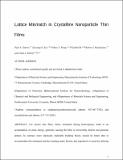Lattice Mismatch in Crystalline Nanoparticle Thin Films
Author(s)
Gabrys, Paul Anthony; Macfarlane, Robert J
DownloadAccepted version (920.0Kb)
Publisher Policy
Publisher Policy
Article is made available in accordance with the publisher's policy and may be subject to US copyright law. Please refer to the publisher's site for terms of use.
Terms of use
Metadata
Show full item recordAbstract
For atomic thin films, lattice mismatch during heteroepitaxy leads to an accumulation of strain energy, generally causing the films to irreversibly deform and generate defects. In contrast, more elastically malleable building blocks should be better able to accommodate this mismatch and the resulting strain. Herein, that hypothesis is tested by utilizing DNA-modified nanoparticles as "soft," programmable atom equivalents to grow a heteroepitaxial colloidal thin film. Calculations of interaction potentials, small-angle X-ray scattering data, and electron microscopy images show that the oligomer corona surrounding a particle core can deform and rearrange to store elastic strain up to ±7.7% lattice mismatch, substantially exceeding the ±1% mismatch tolerated by atomic thin films. Importantly, these DNA-coated particles dissipate strain both elastically through a gradual and coherent relaxation/broadening of the mismatched lattice parameter and plastically (irreversibly) through the formation of dislocations or vacancies. These data also suggest that the DNA cannot be extended as readily as compressed, and thus the thin films exhibit distinctly different relaxation behavior in the positive and negative lattice mismatch regimes. These observations provide a more general understanding of how utilizing rigid building blocks coated with soft compressible polymeric materials can be used to control nano- and microstructure.
Date issued
2018-01Department
Massachusetts Institute of Technology. Department of Materials Science and EngineeringJournal
Nano Letters
Publisher
American Chemical Society (ACS)
Citation
Gabrys, Paul A et al. “Lattice Mismatch in Crystalline Nanoparticle Thin Films.” Nano Letters, 18, 1 (January 2018): 579-585 © 2018 The Author(s)
Version: Author's final manuscript
ISSN
1530-6984